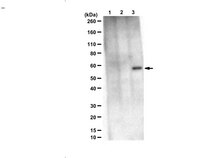ABN1681 Sigma-AldrichAnti-Phospho-PANX1 (Tyr198)
Anti-Phospho-PANX1 (Tyr198), Cat. No. ABN1681, is a highly specific rabbit polyclonal antibody that targets Pannexin 1 and has been tested in Immunofluorescence and Western blotting.
More>> Anti-Phospho-PANX1 (Tyr198), Cat. No. ABN1681, is a highly specific rabbit polyclonal antibody that targets Pannexin 1 and has been tested in Immunofluorescence and Western blotting. Less<<Productos recomendados
Descripción
| Replacement Information |
|---|
Tabla espec. clave
| Species Reactivity | Key Applications | Host | Format | Antibody Type |
|---|---|---|---|---|
| H | WB, IF | Rb | Purified | Polyclonal Antibody |
| References |
|---|
| Product Information | |
|---|---|
| Format | Purified |
| Presentation | Purified rabbit polyclonal antibody in buffer containing 0.1 M Tris-Glycine (pH 8.0), 0.1% BSA without azide. |
| Quality Level | MQ100 |
| Physicochemical Information |
|---|
| Dimensions |
|---|
| Materials Information |
|---|
| Toxicological Information |
|---|
| Safety Information according to GHS |
|---|
| Safety Information |
|---|
| Storage and Shipping Information | |
|---|---|
| Storage Conditions | Stable for 1 year at 2-8°C from date of receipt. |
| Packaging Information | |
|---|---|
| Material Size | 100 µL |
| Transport Information |
|---|
| Supplemental Information |
|---|
| Specifications |
|---|
| Global Trade Item Number | |
|---|---|
| Número de referencia | GTIN |
| ABN1681 | 04054839176579 |
Documentation
Anti-Phospho-PANX1 (Tyr198) Ficha datos de seguridad (MSDS)
| Título |
|---|
Anti-Phospho-PANX1 (Tyr198) Certificados de análisis
| Cargo | Número de lote |
|---|---|
| Anti-Phospho-PANX1 (Tyr198) - 3188576 | 3188576 |
| Anti-Phospho-PANX1 (Tyr198) - 3419598 | 3419598 |
| Anti-Phospho-PANX1 (Tyr198) - 3419598A | 3419598A |
| Anti-Phospho-PANX1 (Tyr198) Polyclonal Antibody | Q2831711 |








